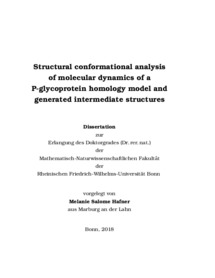Structural conformational analysis of molecular dynamics of a P-glycoprotein homology model and generated intermediate structures

Structural conformational analysis of molecular dynamics of a P-glycoprotein homology model and generated intermediate structures

| dc.contributor.advisor | Wiese, Michael | |
| dc.contributor.author | Hafner, Melanie Salome | |
| dc.date.accessioned | 2020-04-26T21:49:01Z | |
| dc.date.available | 2020-04-26T21:49:01Z | |
| dc.date.issued | 02.10.2019 | |
| dc.identifier.uri | https://hdl.handle.net/20.500.11811/8051 | |
| dc.description.abstract | The major reason for failure of chemotherapy in cancer is multidrug resistance. A mechanism by which human cancers develop multi-drug resistance is over expression of certain ATP-binding cassette (ABC) transporters. P-glycoprotein (P-gp) is one prominent member of the ABC transporter family. One of the strategies to overcome resistance due to P-gp, is the investigation to inhibit its function. However, the basis of drug recognition, as well as its transport has not been clarified. To date, several conformations of bacteria, nematode and murine P-gp could be crystallized. Aim was to generate different human P-gp conformations the transporter might pass through its transition from an active to an inactive form. In this work, a homology model was build using a murine crystal structure. This homology model, which represents P-gp in a conformation with the nucleotide binding domains open (NBD-open) and a homology model of P-gp with the nucleotide binding domains dimerized (NBD-closed) were used to generate 18 transition states of P-gp. In addition to the two homology models, three generated P-gp conformations were taken to perform molecular dynamics simulations (MD), to investigate possible flexible structures within the P-gp. Further, three substrates and four inhibitors were docked into the high affinity P-gp NBD-open conformation to examine the influence of a ligand. Additionally principal component analysis were performed. All five P-gp conformations showed a good quality comparable to the crystal structures. The performed MDs showed, that a ligand enhances the closure of the nucleotide binding domains, and therefore induces a conformational change of P-gp. By flexibility studies, three putative hinge regions within the transporter were characterized. The hinge regions appeared in all conformations independent of the presence of substrate. Correlated motions, of connecting helices and their counterparts within P-gp were identified. The results obtained from this study are promising for the ongoing research to understand the function of P-glycoprotein. | |
| dc.language.iso | eng | |
| dc.rights | In Copyright | |
| dc.rights.uri | http://rightsstatements.org/vocab/InC/1.0/ | |
| dc.subject | P-gp | |
| dc.subject | P-glycoprotein | |
| dc.subject | Conformation | |
| dc.subject | Molecular Dynamics | |
| dc.subject | Principal Component Analysis | |
| dc.subject | MD | |
| dc.subject | PCA | |
| dc.subject.ddc | 500 Naturwissenschaften | |
| dc.title | Structural conformational analysis of molecular dynamics of a P-glycoprotein homology model and generated intermediate structures | |
| dc.type | Dissertation oder Habilitation | |
| dc.publisher.name | Universitäts- und Landesbibliothek Bonn | |
| dc.publisher.location | Bonn | |
| dc.rights.accessRights | openAccess | |
| dc.identifier.urn | https://nbn-resolving.org/urn:nbn:de:hbz:5n-55317 | |
| ulbbn.pubtype | Erstveröffentlichung | |
| ulbbnediss.affiliation.name | Rheinische Friedrich-Wilhelms-Universität Bonn | |
| ulbbnediss.affiliation.location | Bonn | |
| ulbbnediss.thesis.level | Dissertation | |
| ulbbnediss.dissID | 5531 | |
| ulbbnediss.date.accepted | 23.07.2019 | |
| ulbbnediss.institute | Mathematisch-Naturwissenschaftliche Fakultät : Fachgruppe Pharmazie / Pharmazeutisches Institut | |
| ulbbnediss.fakultaet | Mathematisch-Naturwissenschaftliche Fakultät | |
| dc.contributor.coReferee | Schiedel, Anke C. |
Files in this item
This item appears in the following Collection(s)
-
E-Dissertationen (4118)




